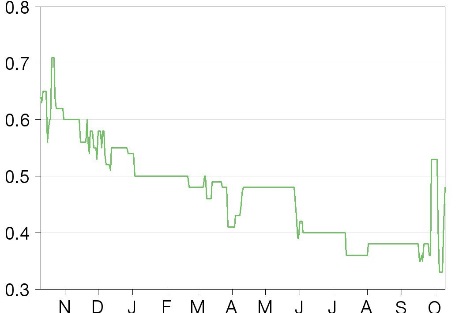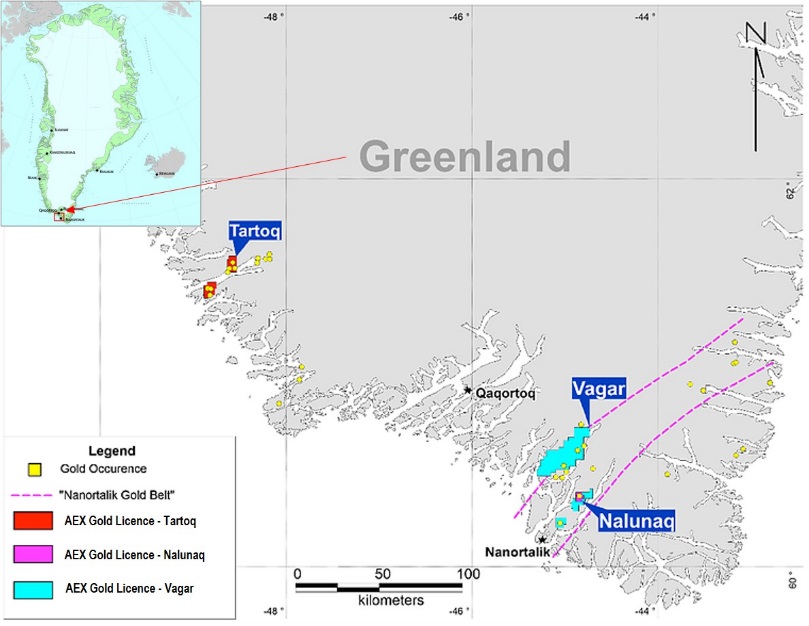Nalunaq: A previously operating gold mine
Nalunaq is an advanced exploration project and AEX’s main focus, with the licence area encompassing the previously operating Nalunaq gold mine, which hosts a NI 43-101 resource estimate. AEX’s strategy is to identify gold mineralisation and delineate new additional resources adjacent to and beyond the former mine area. Work by AEX so far has focused on gathering data and increasing understanding of the Nalunaq deposit and tracing the continuity of the Main Vein “MV” structure, which hosts the gold mineralisation in the area.
Geology and mineralisation: High-grade vein-hosted gold
The Nalunaq deposit project lies within the ‘Psammite Zone’ in south Greenland, host to the Nanortalik Gold Belt, postulated to be a continuation of the Swedish Gold Line. The geology of the Nalunaq mine area is dominated by fine- to medium-grained tholeiitic basalt flows, which have been metamorphosed to amphibolite facies, forming part of a nappe complex that has been thrust over metasediments.
Gold mineralisation at Nalunaq is classified as high-grade, narrow-vein orogenic gold lode type and is hosted in a feature known as the MV. The vein varies in thickness from 0.1m to 2m but significant continuity has been demonstrated for a strike length of over 1,000m and up and down dip for 2,000m. The key focus of AEX’s exploration programme is to investigate extensions of the MV in the wider licence area.
Exhibit 3: MV structure at Nalunaq (left) and high-grade quartz vein sample from Nalunaq MV (right)
|

|
Source: Cross section AEX Gold; photograph SRK, after Crew Gold Corporation.
|
In 2016, SRK Exploration Services compiled an NI 43-101 compliant mineral resource estimate on behalf of AEX at Nalunaq. The total inferred resource amounts to 446kt at 18.7g/t Au for 263koz contained gold, with the resource calculated at a gold price of US$1,300/oz and a cut-off grade of 5.5g/t Au in the mine area. The resource is split into the area surrounding the current mine layout, and in-situ remnant material comprised of material within the mine that could practically and safely be mined as part of a larger exploration or mining operation. Gold mineralisation is high-grade, but erratic as befitting a vein-type deposit with a high nugget effect. The company believes that the magnitude of the gold resource may have been previously underestimated due to the challenges of resource estimation inherent in high nugget-effect deposits such as this.
Exhibit 4: Nalunaq diluted mineral resource estimate
|
Zone |
Classification |
Tonnes (t) |
Grade (g/t Au) |
Contained gold (oz) |
Remnant material |
Inferred |
18,900 |
27.6 |
16,770 |
Mine area |
Inferred |
428,000 |
17.9 |
246,300 |
Total inferred |
|
446,900 |
18.7 |
263,070 |
|
Source: SRK Exploration (Nalunaq NI 43-101, March 2017)
|
Exploration target: in addition to the updated resource estimate, SRK generated an exploration target range of between 80koz and 1.2Moz of gold contained within 1-2Mt grading between 2.5 and 19g/t Au. SRK’s estimate is based on extrapolating data from the mine area across the rest of the known MV structure as well as down-dip below the South Block. This is based on surface diamond drilling and channel and surface samples from 2015–2016. Investigating the potential of this exploration target was a priority of AEX’s initial 2017 exploration programme.
Exhibit 5: Schematic view of Nalunaq Mountain
|

|
|
|
Nalunaq’s exploration and gold production history
Gold was first discovered at Nalunaq in 1986 and the main quartz-vein was discovered in 1992 by NunaOil prompting further exploration. NunaOil entered into a JV with Mindex in 1997 and a major exploration programme was undertaken in 1998 and 1999 including significant surface drilling and an underground drive. Mindex merged with Crew Development Corporation in 1999 and became the operator, completing a PFS later in 1999. An underground development programme commenced in 2000 (managed by Strathcona), which included 1,902m of lateral development, bulk sampling and a pilot plant operation. The MV has been subject to over 30,000m of surface drilling and 5,572m of underground development.
Exhibit 6: Exploration and mining history of Nalunaq
|

|
|
|
Two periods of gold production. After a feasibility study in 2002, Crew Gold Corporation commenced mining in 2004. No processing was carried out on site and from 2004 to 2006, ore was transported to a processing plant in Spain. Then from 2006 until 2009, it was shipped to Crew’s Nugget Pond processing plant in Newfoundland. Crew produced a total of 352koz gold from 654kt of processed ore during. Production peaked at c 71koz in 2007. The mine was put on care and maintenance in February 2009, being a non-core asset for Crew.
Angel Mining acquired the mine in 2009 and spent $35m on an underground processing plant, pouring first gold in May 2011 with a target of 24koz pa, although this was never reached due to challenging logistics and production delays as a result of pump and generator failures. Production averaged 600oz per month during Angel Mining’s tenure, below the targeted 2,000oz/m. Due to financial difficulties and the company’s inability to repay loans, Angel Mining went into administration in February 2013 and the mine operated until August 2013. In 2015, Angel Mining concluded a sale agreement and the licence was transferred to Nalunaq A/S. AEX believes there is considerable scope to optimise and improve on the previous mining and processing operation run by Angel Mining (see next page).
Exhibit 7: Nalunaq – historical gold production
|

|
|
|
















